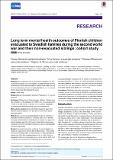| dc.contributor.author | Santavirta, Torsten | en_US |
| dc.contributor.author | Santavirta, Nina | en_US |
| dc.contributor.author | Betancourt, Theresa S | en_US |
| dc.contributor.author | Gilman, Stephen E | en_US |
| dc.date.accessioned | 2015-02-02T15:31:41Z | |
| dc.date.issued | 2015 | en_US |
| dc.identifier.citation | Santavirta, Torsten, Nina Santavirta, Theresa S Betancourt, and Stephen E Gilman. 2015. “Long term mental health outcomes of Finnish children evacuated to Swedish families during the second world war and their non-evacuated siblings: cohort study.” BMJ : British Medical Journal 350 (1): g7753. doi:10.1136/bmj.g7753. http://dx.doi.org/10.1136/bmj.g7753. | en |
| dc.identifier.issn | 0959-8138 | en |
| dc.identifier.uri | http://nrs.harvard.edu/urn-3:HUL.InstRepos:13890597 | |
| dc.description.abstract | Objectives: To compare the risks of admission to hospital for any type of psychiatric disorder and for four specific psychiatric disorders among adults who as children were evacuated to Swedish foster families during the second world war and their non-evacuated siblings, and to evaluate whether these risks differ between the sexes. Design: Cohort study. Setting: National child evacuation scheme in Finland during the second world war. Participants: Children born in Finland between 1933 and 1944 who were later included in a 10% sample of the 1950 Finnish census ascertained in 1997 (n=45 463; women: n=22 021; men: n=23 442). Evacuees in the sample were identified from war time government records. Main outcome measure Adults admitted to hospital for psychiatric disorders recorded between 1971 and 2011 in the Finnish hospital discharge register. Methods: We used Cox proportional hazards models to estimate the association between evacuation to temporary foster care in Sweden during the second world war and admission to hospital for a psychiatric disorder between ages 38 and 78 years. Fixed effects methods were employed to control for all unobserved social and genetic characteristics shared among siblings. Results: Among men and women combined, the risk of admission to hospital for a psychiatric disorder did not differ between Finnish adults evacuated to Swedish foster families and their non-evacuated siblings (hazard ratio 0.89, 95% confidence interval 0.64 to 1.26). Evidence suggested a lower risk of admission for any mental disorder (0.67, 0.44 to 1.03) among evacuated men, whereas for women there was no association between evacuation and the overall risk of admission for a psychiatric disorder (1.21, 0.80 to 1.83). When admissions for individual psychiatric disorders were analyzed, evacuated girls were significantly more likely than their non-evacuated sisters to be admitted to hospital for a mood disorder as an adult (2.19, 1.10 to 4.33). Conclusions: The Finnish evacuation policy was not associated with an increased overall risk of admission to hospital for a psychiatric disorder in adulthood among former evacuees. In fact, evacuation was associated with a marginally reduced risk of admission for any psychiatric disorder among men. Among women who had been evacuated, however, the risk of being admitted to hospital for a mood disorder was increased. | en |
| dc.language.iso | en_US | en |
| dc.publisher | BMJ Publishing Group Ltd. | en |
| dc.relation.isversionof | doi:10.1136/bmj.g7753 | en |
| dc.relation.hasversion | http://www.ncbi.nlm.nih.gov/pmc/articles/PMC4283996/pdf/ | en |
| dash.license | LAA | en_US |
| dc.title | Long term mental health outcomes of Finnish children evacuated to Swedish families during the second world war and their non-evacuated siblings: cohort study | en |
| dc.type | Journal Article | en_US |
| dc.description.version | Version of Record | en |
| dc.relation.journal | BMJ : British Medical Journal | en |
| dash.depositing.author | Betancourt, Theresa S | en_US |
| dc.date.available | 2015-02-02T15:31:41Z | |
| dc.identifier.doi | 10.1136/bmj.g7753 | * |
| dash.authorsordered | false | |
| dash.contributor.affiliated | Betancourt, Theresa | |
| dash.contributor.affiliated | Gilman, Stephen Edward | |


